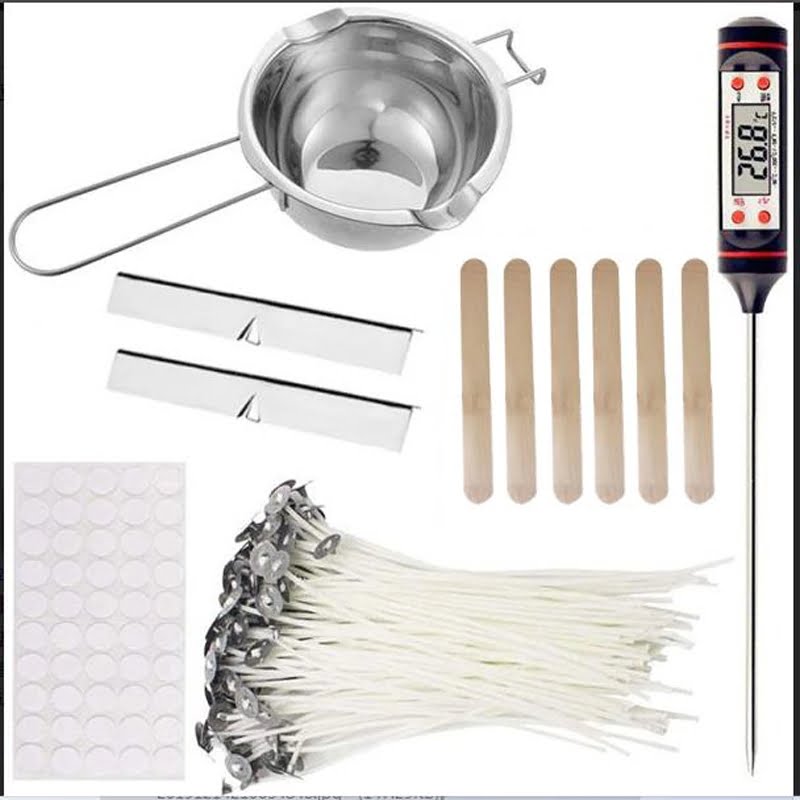Candle making has become an increasingly popular hobby and entrepreneurial venture in recent years. With the growing demand for unique, handmade products, homemade candles have found a special place in the hearts of consumers. But just how profitable is this craft? In this blog post, we will delve into the world of candle making and explore its potential as a lucrative business opportunity for aspiring entrepreneurs.
The global candle industry has experienced exponential growth, with consumers increasingly seeking natural and sustainable alternatives to mass-produced candles. This market trend opens up exciting possibilities for candle makers who can tap into this niche by providing high-quality, eco-friendly products. Understanding the market potential is crucial for assessing the profitability of starting a candle making business.
However, profitability isn’t solely determined by market demand. Costs and initial investment play a significant role as well. In this article, we will break down the essential materials and equipment needed for candle making and calculate the initial capital required to start your own business. We will also discuss cost-saving methods and tips for beginners looking to minimize expenses without compromising on quality.
Stay tuned as we explore pricing strategies and profit margins specific to candle making. From cost-plus to market-based pricing models, understanding how to effectively price your candles ensures you maximize profits while remaining competitive in a saturated market. We will also address factors that affect overall profitability, including raw material cost fluctuations, efficient production techniques, and effective marketing strategies.
Through real-life success stories in the industry, we will highlight individuals who have achieved profitability in their candle making ventures. These case studies will shed light on unique value propositions, innovative marketing strategies, and successful business models that contribute to their success. By analyzing these examples, you can gain valuable insights on how to maximize profitability in your own candle-making journey.
In subsequent sections of this blog post series, we will provide tips on enhancing profitability through expanding product lines, targeting niche markets, utilizing social media for promotion, customer retention strategies, building a strong brand identity, and considerations for scaling up and expanding a candle making business. By the end of this series, you’ll have a comprehensive understanding of the profitability potential in the world of candle making.
Before we embark on this exciting journey, it is important to consider your personal goals, resources, and market conditions. Candle making can be a profitable business, but success depends on various factors. In the following sections, we will provide you with the necessary information to make an informed decision and answer the question: just how profitable is candle making? Let’s dive in.
Understanding the Market Potential for Candle Making
The candle making industry has witnessed exponential growth in recent years, making it a potentially lucrative business opportunity for aspiring entrepreneurs. Understanding the market potential for candle making is crucial for those considering entering this industry. This section will analyze the growth of the global candle industry and explore market trends that contribute to its profitability.
Analyzing the Exponential Growth
The global candle industry has experienced remarkable growth, driven by increasing consumer demand for scented and decorative candles. According to reports, the market size was valued at $3.45 billion in 2020 and is projected to reach $5.22 billion by 2028. This significant growth can be attributed to various factors such as rising disposable incomes, expanding e-commerce platforms, and growing popularity of aromatherapy.
Market Trends: Natural and Sustainable Products
In addition to overall market growth, there is a noticeable trend towards natural and sustainable candle products. Consumers are becoming more conscious about the impact of their choices on the environment and are actively seeking eco-friendly alternatives. This shift in consumer preferences presents a unique opportunity for candle makers who prioritize using natural ingredients, recyclable packaging, and sustainable production practices.
To tap into this growing market potential, candle makers can focus on offering a range of environmentally friendly options such as soy wax candles, beeswax candles, or those made from other renewable resources. By aligning their offerings with eco-conscious consumers’ values, candle makers can attract a loyal customer base willing to pay a premium price for sustainable products.
Understanding the market potential allows prospective candle makers to gauge the opportunities available to them in terms of customer demand and target markets. By leveraging market trends like the preference for natural and sustainable products, entrepreneurs can position themselves strategically within this flourishing industry.
Costs and Initial Investment in Candle Making
Candle making may seem like a simple and cost-effective business to start, but it is important for potential entrepreneurs to understand the costs and initial investment involved. In this section, we will break down the essential materials and equipment needed for candle making, calculate the initial capital required, and discuss potential cost-saving methods and tips for beginners.
When starting a candle making business, there are several key materials and equipment that are necessary. These include wax, wicks, fragrance oils or essential oils, containers or molds, a pouring pot or double boiler, a thermometer, a scale, and various tools for stirring and pouring. The cost of these items can vary depending on the quality and quantity desired. It is advisable to research different suppliers to find the best prices without compromising on quality.
In addition to materials and equipment, there are other costs to consider when starting a candle making business. These include packaging materials such as labels or tags, shipping supplies if selling online, marketing materials for promoting the candles such as business cards or brochures, and potentially renting studio space if not operating from home. It is important to create a comprehensive list of all the necessary expenses in order to accurately calculate the initial investment required.
To save on costs initially, beginners can consider purchasing starter kits that contain most of the essential materials needed for candle making. These kits often include step-by-step instructions and can be a great way to test out different techniques before investing in larger quantities of supplies.
It is also possible to find second-hand equipment or source some materials locally for lower prices. Researching wholesale options for purchasing bulk quantities of supplies can also lead to significant savings in the long run.
| Materials | Average Cost |
|---|---|
| Wax (1 pound) | $5 – $15 |
| Wicks (pack of 100) | $5 – $10 |
| Fragrance Oils or Essential Oils (2 ounces) | $5 – $20 |
| Containers or Molds | $1 – $10 each |
| Pouring Pot or Double Boiler | $10 – $30 |
By carefully considering the costs and investing in high-quality materials and equipment, it is possible to start a candle making business with a relatively modest initial investment. As with any business, it is important to research and plan ahead to ensure success in the long term.
Pricing Strategies and Profit Margins in Candle Making
Candle making can be a profitable business venture, but it is crucial to have effective pricing strategies and be aware of profit margins. Pricing handmade candles involves considering various factors, including the cost of materials, labor, overhead expenses, and desired profit margin.
One common pricing strategy in candle making is the cost-plus pricing model. This approach involves calculating the total cost of producing a candle and then adding a markup to cover overhead expenses and generate profit. The markup percentage should reflect the quality and uniqueness of the candles as well as market demand.
Another pricing strategy is the market-based pricing model. This approach involves analyzing competitors’ prices and determining where your candles fit in terms of quality, design, and target market. It is essential to find a balance between setting competitive prices that attract customers while still ensuring profitability.
To calculate profit margins in candle making, you need to subtract the actual costs from the selling price. Profit margins are typically expressed as a percentage of revenue or as a monetary value per unit sold. It is advisable to set profit margins at a level that allows for reinvestment into your business, future growth opportunities, and sustainability.
It’s important to note that pricing strategies can vary based on factors such as region, target market, competition, and production costs. Additionally, regular evaluation and adjustment of pricing strategies may be necessary due to changes in raw material costs or market conditions.
| Pricing Strategy | Description |
|---|---|
| Cost-Plus Pricing Model | Calculating total production cost and adding a markup for overhead expenses and desired profit. |
| Market-Based Pricing Model | Analyzing competitors’ prices and positioning your candles based on quality, design, and target market. |
Evaluating Factors That Affect Candle Making Profitability
Impact of Raw Material Cost Fluctuations
One of the key factors that can greatly affect the profitability of candle making is the cost of raw materials. As with any business, it’s important to keep track of and be prepared for fluctuations in the prices of essential ingredients like wax, wicks, fragrances, and dyes. These costs can vary due to factors such as changes in supply and demand, availability of resources, and economic conditions.
To mitigate the impact of raw material cost fluctuations on your profit margins, it is advisable to establish good relationships with suppliers and negotiate favorable pricing terms. Additionally, staying informed about market trends can help you anticipate price changes and adjust your pricing strategies accordingly.
Efficient Production Techniques and Minimizing Wastage
Efficient production techniques are crucial for maximizing profitability in candle making. By optimizing your manufacturing processes, you can reduce production time and minimize wastage of materials. This can be achieved through various methods such as using precise measurements when creating candle recipes, investing in equipment that enables efficient production, and training staff on proper handling techniques.
Minimizing wastage not only helps maintain a healthy profit margin but also contributes to sustainability efforts which are increasingly valued by consumers. By finding creative ways to repurpose excess wax or collaborating with recycling programs, you can both cut costs and improve your brand’s image as an eco-friendly candle maker.
Influence of Marketing and Branding
Marketing and branding play a significant role in determining the profitability of a candle making business. Building a strong brand identity that resonates with target customers helps differentiate your candles from competitors’ products and create a loyal customer base.
Investing in effective marketing strategies such as social media promotion, influencer collaborations, or participating in craft fairs or local markets can help raise awareness about your candles and attract potential customers. Leveraging the power of storytelling and highlighting the unique aspects of your candles, such as their handmade nature or sustainable ingredients, can further enhance their perceived value and justify higher price points.
Case Studies
In this section, we will explore some real-life examples of individuals who have achieved profitability in the candle making industry. These success stories not only provide inspiration but also shed light on the strategies and approaches that have contributed to their achievements.
One such success story is the case of Angela, a candle maker from a small town. Angela started her candle making business as a side project, making candles as gifts for friends and family. With positive feedback and increasing demand, she decided to turn her passion into a profitable venture.
Angela focused on creating unique scents and aesthetically pleasing designs that appealed to her target market. She also invested time and effort in building an engaging online presence through social media platforms like Instagram and Facebook, which helped her gain visibility and attract customers. By prioritizing customer satisfaction, offering personalized services, and continuously improving her craft, Angela was able to establish a loyal customer base and achieve significant profitability.
Another success story is the case of David, who began his candle making business with a different approach. David identified a niche market of eco-conscious consumers who were looking for sustainable alternatives to traditional candles. He created a line of organic, vegan candles using natural ingredients such as soy wax and essential oils.
Through effective branding and marketing strategies focused on highlighting the environmental benefits of his products, David was able to carve out a unique position in the market. By targeting specific retail stores and attending local trade shows, he successfully expanded his distribution channels and increased his profitability.
These case studies demonstrate that profitability in candle making is indeed achievable with the right strategies, dedication, and perseverance. It is important to note that each success story had its own unique value proposition and marketing approach tailored to their target market. Therefore, aspiring entrepreneurs should conduct thorough market research, identify their target audience’s preferences, and develop a strong brand identity to maximize their chances of success in this competitive industry.
By learning from these success stories and adapting their strategies to fit individual circumstances, aspiring candle makers can increase their chances of achieving profitability in the candle making business. It is crucial to understand that profitability in candle making is not guaranteed, but with careful planning, a strong business model, and a focus on quality and customer satisfaction, it can be a lucrative venture for those willing to put in the effort.
Tips to Maximize Profitability in Candle Making
Running a profitable candle making business requires more than just creating beautiful candles. To maximize profitability, candle makers need to implement strategies that can help them stand out in the market and attract customers. Here are some practical tips to enhance profitability in candle making:
- Expand product lines: Offering a diverse range of candle products can attract a wider customer base and increase sales. Consider creating different sizes, shapes, scents, or even personalized candles for special occasions. This expansion not only appeals to a larger audience but also increases the likelihood of repeat purchases.
- Target niche markets: While catering to a broad market is important, targeting niche markets can be highly lucrative. Explore untapped segments such as eco-conscious consumers who prefer sustainable and natural candles, or luxury customers who gravitate towards high-end designer candles. Researching your target audience and tailoring your products accordingly can give you a competitive edge.
- Utilize social media for promotion: Leverage social media platforms like Instagram, Facebook, and Pinterest to showcase your unique candle creations and engage with potential customers. Share captivating visuals of your candles being made or burning in different settings. Collaborate with influencers or bloggers in the home decor or self-care niche to reach a wider audience and boost brand awareness.
- Prioritize customer retention: Acquiring new customers is essential, but retaining existing ones is equally important for long-term profitability. Offer incentives for repeat purchases such as loyalty programs, exclusive discounts, or special limited-edition releases for loyal customers. Providing exceptional customer service and promptly addressing any issues will help build strong relationships with your clientele.
- 5.Build a strong brand identity: In a saturated market, having a compelling brand identity sets you apart from competitors. Define your unique selling proposition (USP) and communicate it effectively through branding elements like packaging design, logo, website layout, and marketing materials. Consistency across all touchpoints reinforces trust among customers and makes your brand memorable.
By implementing these tips, candle makers can enhance their profitability and build a sustainable business. Remember to continuously analyze market trends, listen to customer feedback, and innovate to stay relevant in the dynamic candle making industry. With dedication, creativity, and strategic planning, candle making can indeed be a profitable venture.
Considerations for Scaling Up and Expanding a Candle Making Business
Scaling up and expanding a candle making business can be an exciting opportunity for entrepreneurs looking to maximize profitability. However, it is crucial to carefully consider various factors before taking the leap into growth and expansion. This section will outline key considerations and offer guidance on how to scale up a candle making venture successfully.
- Streamlining Operations: As a candle making business expands, it becomes essential to streamline operations to enhance efficiency. This can include optimizing production processes, implementing quality control measures, and investing in advanced equipment and technology. By streamlining operations, businesses can reduce costs, increase productivity, and ensure consistent product quality.
- Hiring Staff: With growth comes the need for additional manpower. When scaling up a candle making business, entrepreneurs should consider hiring staff to meet the increased production demands. It is crucial to hire skilled employees who are passionate about the craft of candle making and align with the company’s values. Proper training and clear communication channels are necessary to maintain product consistency and uphold brand standards.
- Developing Distribution Channels: Expanding a candle making business requires thoughtful consideration of distribution channels. Entrepreneurs need to assess whether they want to focus on selling directly to consumers through an online platform or explore partnerships with retailers or wholesalers. Each distribution channel has its advantages and challenges, so careful evaluation is necessary based on market demand, target audience, and overall business objectives.
- Managing Finances: Scaling up a business often requires significant financial investments. Entrepreneurs should plan their finances accordingly by assessing projected costs for scaling production capacity, hiring staff, increasing marketing efforts, and expanding distribution channels. It may be necessary to seek external funding options such as loans or investors to support expansion plans effectively.
- Building Brand Consistency: As a candle making business grows, maintaining brand consistency becomes crucial for continued success. Businesses should invest in creating a strong brand identity that resonates with their target audience. This includes cohesive packaging design, consistent product quality, and effective branding and marketing strategies. Building brand loyalty and ensuring a positive customer experience will contribute to long-term profitability.
By carefully considering these factors, candle making entrepreneurs can scale up their business successfully and maximize profitability. However, thorough market research and strategic planning are essential to understand the demand, competition, and potential challenges associated with growth. With the right approach, scaling up can lead to increased revenue, market share expansion, and establishing a strong position in the candle making industry.
Conclusion
In conclusion, the question of whether candle making is a profitable business can be answered with a resounding “yes.” Throughout this blog post, we have explored the various factors that contribute to the profitability of candle making. From understanding the market potential and identifying pricing strategies to evaluating key factors and learning from success stories, it is clear that there are ample opportunities for entrepreneurs in this industry.
The exponential growth of the global candle industry and the increasing demand for natural and sustainable products present a favorable market landscape for candle makers. By carefully considering costs, initial investments, and pricing strategies, entrepreneurs can ensure they achieve healthy profit margins. Additionally, efficiency in production techniques, minimizing wastage, effective marketing strategies, and building a strong brand identity play crucial roles in enhancing profitability.
While candle making can indeed be a profitable endeavor, it is important for aspiring entrepreneurs to factor in their personal goals, available resources, and market conditions before embarking on this venture. Each individual’s circumstances will differ, so it is essential to conduct thorough research and assess one’s own abilities and constraints.
Ultimately, with careful planning and strategic execution, candle making can offer not only financial rewards but also the satisfaction of creating unique products that bring joy to customers’ lives. So if you have a passion for candles and are willing to invest time and effort into building your business, there is great potential for profitability in the world of candle making.
Frequently Asked Questions
Do homemade candles sell well?
Homemade candles can indeed sell well, as there is a demand for unique and artisanal products in the market. Many people appreciate the craftsmanship and personal touch that comes with homemade candles, making them popular choices for gifts or personal use.
The key to success lies in creating high-quality candles with appealing designs, using premium ingredients and materials. Additionally, marketing and promoting the candles effectively plays a crucial role in attracting potential customers.
How much can you make selling homemade candles?
The amount of money one can make by selling homemade candles varies depending on various factors such as the production costs, pricing strategy, demand for the product, and marketing efforts. Some skilled candle makers have been able to turn their businesses into profitable ventures, generating substantial income from selling their handmade creations.
However, it is important to note that making a significant profit may take time and effort, especially when starting as a small-scale operation. It is also necessary to factor in expenses such as raw materials, packaging supplies, marketing costs, and overhead expenses.
How much money do candle makers make?
The earnings of candle makers vary widely depending on several factors including the size of their business operations, market demand for their products, price points set on their candles, production costs involved like sourcing raw materials or ingredients in bulk at lower prices to maximize profitability.
While some professional candle makers may be able to generate a full-time income from their craft, especially if they cater to niche markets or have built a strong customer base over time; others may only earn a modest supplementary income through part-time candle making endeavors or by selling at local craft shows or online platforms.

Welcome to my candle making blog! In this blog, I will be sharing my tips and tricks for making candles. I will also be sharing some of my favorite recipes.





